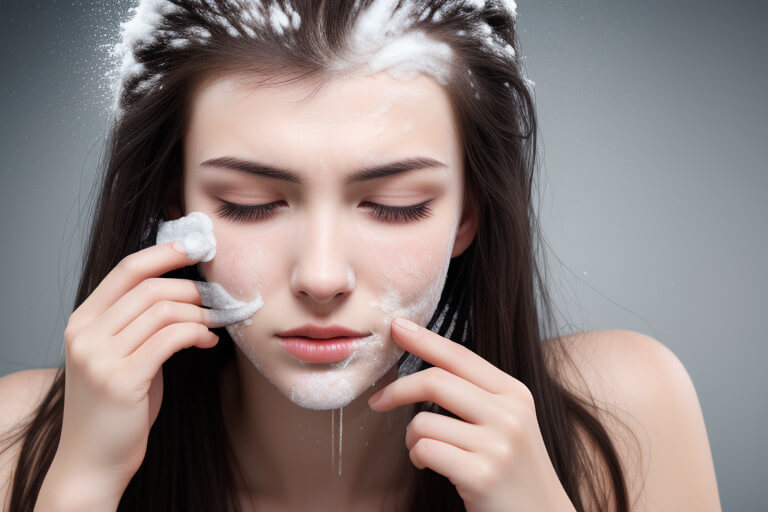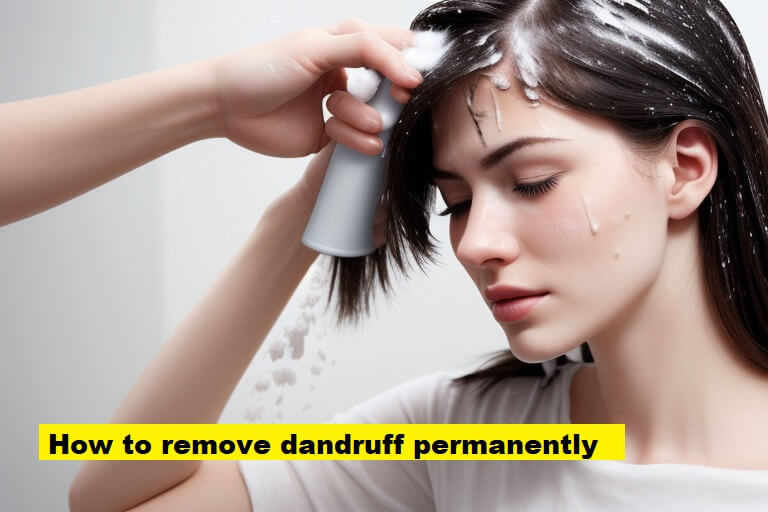How to remove dandruff permanently
How to remove dandruff permanently:- Dandruff is a common scalp condition that affects millions of people worldwide. It can be embarrassing, uncomfortable, and persistent, often leading to decreased self-confidence and social anxiety. While completely permanent removal of dandruff may be challenging for some individuals, there are numerous effective strategies to manage and minimize its occurrence long term. This comprehensive guide will delve deep into the causes of dandruff, explore a wide range of solutions, and provide you with the knowledge to achieve a healthier, flake-free scalp.
Understanding Dandruff
Dandruff is characterized by the shedding of dead skin cells from the scalp at an accelerated rate. While it’s normal for skin cells to die and flake off, dandruff occurs when this process speeds up, leading to visible flakes in the hair and on clothing. Contrary to popular belief, dandruff is not caused by poor hygiene, but rather by a combination of factors that affect scalp health.
Common Causes of Dandruff
To effectively combat dandruff, it’s crucial to understand its root causes:
- Malassezia Fungus: This naturally occurring yeast-like fungus feeds on the oils on your scalp. An overgrowth can irritate the skin and accelerate cell turnover.
- Dry Skin: Especially common in cold, dry climates, dry skin can lead to flaking and itching.
- Oily Skin: Conversely, excessively oily skin (seborrhea) can cause dandruff.
- Sensitivity to Hair Products: Some individuals may react to certain ingredients in shampoos, conditioners, or styling products.
- Skin Conditions: Conditions like seborrheic dermatitis, psoriasis, and eczema can cause dandruff-like symptoms.
- Diet and Lifestyle: Poor nutrition, stress, and certain medications can contribute to dandruff.
- Age and Gender: Dandruff is more common in men and typically starts in young adulthood.
- Medical Conditions: Some neurological and immunological disorders can increase the risk of dandruff.
Symptoms and Diagnosis
The primary symptoms of dandruff include:
- White or yellowish flakes in the hair and on the shoulders
- Itchy, scaly scalp
- Red, irritated skin on the scalp
- Oily patches on the scalp
While dandruff can often be self-diagnosed, persistent or severe cases may require a professional evaluation. A dermatologist can perform a scalp examination and, if necessary, a skin scraping to determine the exact cause and best treatment approach.

Effective Strategies to Remove Dandruff
1. Anti-Dandruff Shampoos
The cornerstone of dandruff treatment is the use of specialized shampoos. Look for products containing these active ingredients:
- Zinc Pyrithione: An antifungal and antibacterial agent that reduces the Malassezia fungus.
- Ketoconazole: A powerful antifungal that’s effective against severe dandruff.
- Selenium Sulfide: Slows cell turnover and has antifungal properties.
- Salicylic Acid: Helps remove scale and reduce scaling.
- Coal Tar: Slows cell turnover and reduces inflammation.
- Piroctone Olamine: An antifungal alternative to zinc pyrithione.
For best results:
- Use the anti-dandruff shampoo daily until symptoms improve, then 2-3 times a week for maintenance.
- Leave the shampoo on for 5 minutes before rinsing to allow the active ingredients to work.
- Rotate between shampoos with different active ingredients to prevent resistance.
2. Scalp Exfoliation
Gentle exfoliation can help remove dead skin cells and control flaking:
- Use a soft-bristled brush or a scalp scrubber while shampooing.
- Try a salicylic acid scalp treatment once a week.
- Be cautious not to over-exfoliate, which can irritate the scalp.
3. Proper Hair Washing Technique
How you wash your hair can significantly impact dandruff:
- Use lukewarm water, as hot water can irritate the scalp.
- Massage the shampoo into your scalp gently but thoroughly.
- Rinse completely to remove all product residue.
- Don’t wash too frequently, as this can strip natural oils and exacerbate dandruff.
4. Medicated Treatments
For more stubborn cases, consider:
- Over-the-counter tar gels or steroid lotions.
- Prescription-strength topical steroids or antifungal medications.
- Medicated shampoos containing ciclopirox.
Natural Remedies for Dandruff
While scientific evidence varies, many people find relief in these natural solutions:
- Tea Tree Oil: Known for its antifungal properties, add a few drops to your shampoo or dilute with a carrier oil for direct application.
- Apple Cider Vinegar: Its acidity may help inhibit yeast growth. Mix equal parts water and ACV for a post-shampoo rinse.
- Aloe Vera: Apply pure aloe vera gel to the scalp for its soothing and antifungal effects.
- Coconut Oil: Its moisturizing and antimicrobial properties can benefit the scalp. Massage into the scalp before washing.
- Baking Soda: Gently exfoliates and may reduce fungal growth. Make a paste with water and use it as a pre-shampoo treatment.
- Omega-3 Fatty Acids: Supplements or foods rich in omega-3s may help reduce inflammation and improve scalp health.
- Probiotics: Both topical and oral probiotics might help balance the scalp’s microbiome.
Lifestyle Changes to Combat Dandruff
Addressing dandruff often requires a holistic approach:
1. Diet Modifications
- Increase intake of zinc-rich foods (pumpkin seeds, beef, lentils)
- Consume more B-vitamin-rich foods (whole grains, leafy greens)
- Add probiotics to your diet (yogurt, kefir, kombucha)
- Reduce sugar and processed foods
- Stay hydrated by drinking plenty of water
2. Stress Management
Chronic stress can exacerbate dandruff. Try:
- Regular exercise
- Meditation or mindfulness practices
- Adequate sleep (7-9 hours nightly)
- Yoga or tai chi
- Breathing exercises
3. Hair Care Habits
- Avoid harsh hair products containing sulfates and parabens
- Limit the use of heat styling tools
- Don’t scratch your scalp, which can increase irritation
- Use a silk or satin pillowcase to reduce friction
4. Environmental Considerations
- Use a humidifier in dry climates to add moisture to the air
- Protect your scalp from excessive sun exposure
- Be mindful of seasonal changes that may affect your scalp
When to Seek Professional Help
Consult a dermatologist if:
- Over-the-counter treatments don’t work after several weeks
- Your scalp becomes very red, swollen, or painful
- You experience hair loss along with dandruff
- The condition spreads to other parts of your body
- You suspect an underlying skin condition
A dermatologist can:
- Perform a thorough scalp examination
- Prescribe stronger medications if needed
- Identify and treat any underlying conditions
- Provide personalized advice based on your specific case
Long-Term Maintenance for a Dandruff-Free Scalp
Once you’ve gotten dandruff under control:
- Continue using anti-dandruff shampoo 1-2 times a week
- Maintain a healthy diet and stress management routine
- Pay attention to how your scalp reacts to different products and environmental factors
- Keep your scalp clean and avoid product buildup
- Regularly clean hair tools and change pillowcases
- Consider seasonal adjustments to your hair care routine
Myths and Misconceptions About Dandruff
Let’s debunk some common myths:
- Myth: Dandruff is caused by poor hygiene. Fact: While cleanliness is important, dandruff is not directly related to how often you wash your hair.
- Myth: Dandruff is contagious. Fact: Dandruff cannot be spread from person to person.
- Myth: Dandruff causes hair loss. Fact: Dandruff itself doesn’t cause hair loss, but excessive scratching can damage hair follicles.
- Myth: You can’t wear dark clothes if you have dandruff. Fact: With proper treatment, you can wear any color clothing without worry.
- Myth: All flakes are dandruff. Fact: Dry scalp and other conditions can also cause flaking, which may require different treatments.
Conclusion
While completely permanent removal of dandruff may not be achievable for everyone, implementing these strategies can lead to significant long-term improvement and management of symptoms. The key to success lies in understanding your specific triggers, finding the right combination of treatments, and maintaining consistent scalp care.
Remember that dandruff is a common condition and nothing to be ashamed of. With patience, persistence, and the right approach, you can achieve a healthier scalp and regain your confidence. If you’re struggling to control your dandruff, don’t hesitate to seek professional advice from a dermatologist who can provide personalized treatment options.
By following this comprehensive guide and adapting the strategies to your individual needs, you’re well on your way to a flake-free, healthier scalp. Stay committed to your scalp care routine, be open to trying different approaches, and celebrate the improvements you see along the way to a dandruff-free life.



